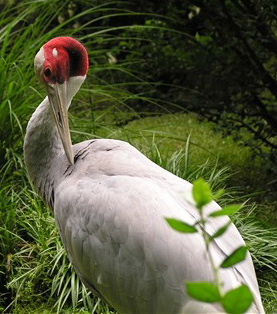|
| Query: Australian insects | Result: 63rd of 133 | |
Sarus Crane (Grus antigone) - Wiki
| Subject: | Sarus Crane (Grus antigone) - Wiki
| |

| Resolution: 277x314
File Size: 58232 Bytes
Date: : : : :
Camera: Exif Viewer Ver.1.1 (FUJIFILM)
Upload Date: 2007:01:01 23:34:28
|
Sarus Crane
From Wikipedia, the free encyclopedia
[Photo] Sarus Crane. Photo by Jcwf.
The Sarus Crane (Grus antigone) is a resident breeding bird in northern India (esp Etawah, Mainpuri area), Nepal, Southeast Asia and Queensland, Australia. It is a very large crane, averaging 156 cm in length, which is found in freshwater marshes and plains.
Description
Adults are grey with a bare red head and white crown and a long dark pointed bill. In flight, the long neck is kept straight, unlike herons, and the black wing tips can be seen; their long red or pink legs trail behind them. The sexes do not differ in color, but young birds are duller and browner. On average the male is larger than the female; Indian males can exceed 180 cm (6 ft) in height, with a wingspan of 250 cm (more than eight ft), making it the world's tallest flying bird alive today.
In Australia, the Sarus can easily be mistaken for the Brolga. The Brolga has a more widespread distribution across Australia, and its red colouring is confined to the head. The Brolga and Sarus are genetically quite distinct.
Distribution and habitat
The Indian population is about 10,000 birds; it used to be found on occasion in Pakistan, but not anymore since the late 1980s. While the Australian population of 5,000 birds may be increasing, the southeast Asian subspecies has been decimated by war and habitat modification and destruction (such as intensive agriculture and draining of wetlands) and by the mid-20th century had disappeared from large parts of its range which once stretched up to southern China. The little-known Philippine population is completely extinct since the late 1960s.
Subspecies
There are up to four subspecies recognized; the nominal form from the Indian subcontinent being most strongly differentiated in having a white collar below the bare head and upper neck, and white tertiary remiges. These areas are grey in the other forms, of which the Indochina subspecies sharpei is smaller than Indian birds, the Australian gilliae smaller still and the birds once found on Luzon, Philippines being smallest of all. Whether these forms are all valid is somewhat disputed; thorough mtDNA analyses, although hampered by the small number of available specimens, suggest that the continental Asian populations had ongoing gene flow until the 20th century range reductions, and that Australia was colonized by this species only in the Late Pleistocene, some 35.000 years ago.[1]
Ecology and behaviour
These birds are usually seen in small groups of 2-5 and they forage while walking in shallow water or in fields, sometimes probing with their long bills. They are omnivorous, eating insects, aquatic plants and animals, crustaceans, seeds and berries, small vertebrates, and invertebrates.
It nests on the ground, laying two to three eggs in a bulky nest. Unlike many cranes which make long migrations, the Sarus Crane does not; there is some short-distance dispersal however. Both the male and female take turns sitting on the nest, and the male is the main protector. They mate for life.
Popular culture
The species is venerated in India and legend has it that Valmiki cursed a hunter for killing a Sarus Crane and was then inspired to write the epic Ramayana.
http://en.wikipedia.org/wiki/Sarus_Crane
| The text in this page is based on the copyrighted Wikipedia article shown in above URL. It is used under the GNU Free Documentation License. You may redistribute it, verbatim or modified, providing that you comply with the terms of the GFDL. |
|
Comments |
|---|
| | Guest |
|
Scientific Name: Antigone antigone (Linnaeus, 1758)
Common Names: Sarus Crane
French: Grue antigone; German: Saruskranich; Spanish: Grulla sarus
Taxonomy: Ardea Antigone Linnaeus, 1758, India.
Synonyms: Grus antigone (Linnaeus, 1758) |
^o^
Animal Pictures Archive for smart phones
^o^
|
|
|

